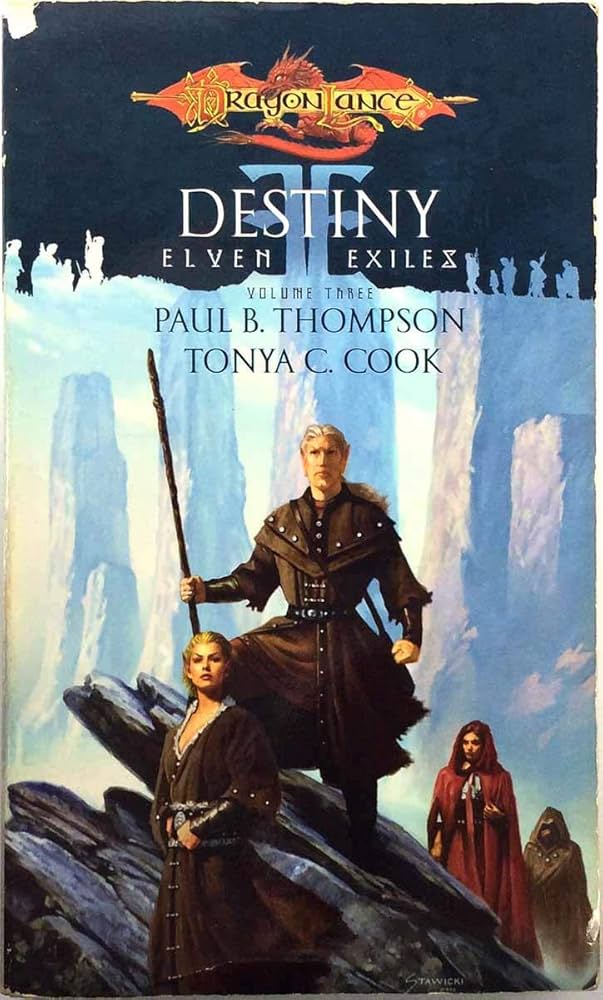Destiny

Table of Contents
ToggleOverview
Destiny, written by Paul B. Thompson and Tonya C. Cook, is the third and final book in the Elven Exiles trilogy within the Dragonlance saga. It completes the emotional and political arc of the exiled Qualinesti and Silvanesti elves as they search for not just a place to call home, but a renewed sense of self and purpose.
This novel is the culmination of a narrative about loss, resilience, leadership, and the painful birth of a new identity. It weaves together the personal journeys of its main characters with the broader destiny of a scattered people trying to become whole again.
Main Characters
Kerianseray (Kerian) – The battle-hardened Lioness of Qualinesti, Kerian continues to fight not only for her people’s safety but for the soul of what it means to be elven. Her strength is tested to the limit.
Gilthas Pathfinder – Once a puppet ruler, now a visionary leader. In Destiny, he steps fully into the role of guide and unifier, risking everything to forge peace and a new homeland.
Alon – The son of Kerian and Gilthas, caught in the whirlwind of generational change. His coming-of-age story echoes the themes of legacy, evolution, and the cost of freedom.
Nerakan Forces and Internal Dissidents – Represent the external and internal pressures threatening to unravel the fragile unity of the elven exiles.
Setting
Set in the fragmented remnants of Ansalon’s political map, the story follows the exiles as they confront both old enemies and new frontiers. Camps, strongholds, ruins, and emerging settlements create a diverse and unstable backdrop.
The novel’s tone is marked by the tension of transition—a people caught between destruction and rebirth.
Plot Summary
As the exiles work to secure land and legitimacy, tensions boil over between factions favoring isolation and those pushing for alliance with human and dwarven neighbors.
Gilthas leads negotiations and reforms, seeking to lay the groundwork for a true homeland. Kerian battles threats from Nerakan aggressors and internal radicals who reject compromise.
Alon steps into a leadership role, representing the future of the elves—a generation unburdened by past divisions but unsure of its place in the world.
In a climactic series of political and military confrontations, sacrifices are made, enemies unmasked, and choices solidified. The elves finally establish a new identity—not as victims, but as survivors forging a shared destiny.
Themes
Legacy and Renewal – The trilogy’s end affirms that history can guide, but not dictate, the future.
Unity in Diversity – Multiple elven traditions must learn to coexist to ensure survival.
Coming of Age – Alon’s journey reflects the larger coming-of-age of the entire elven race.
Diplomacy and Warfare – The dual paths of peace and conflict are shown not as opposites, but as tools of leadership.
Tone & Style
Destiny is emotionally resonant, serious, and hopeful. The prose remains grounded in character while conveying the sweeping challenges of a people in flux.
It maintains a balance of introspection, political drama, and decisive action.
Reception
Praised for:
A satisfying conclusion to complex character arcs.
Emotional payoff built from long-term political and familial tensions.
Capturing the spirit of resilience in a fantasy world undergoing transformation.
Some critiques:
Less traditional fantasy adventure; more political and emotional in scope.
Requires investment in the full trilogy for maximum impact.
Final Thoughts
Destiny closes the Elven Exiles trilogy with strength, grace, and vision. It affirms that home is not a place reclaimed—but a future built together. The story honors tradition while embracing the need for change, making it one of the most poignant explorations of elven identity in the Dragonlance canon.
Recommended for:
Fans of thoughtful, character-driven fantasy.
Anyone seeking a tale of rebuilding, reconciliation, and rightful belonging.
